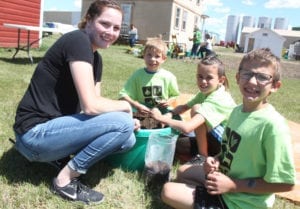
Members of the Kindersley Antique Threshing Club use horse teams and vintage farm implements to seed oats on five acres of land on the west side of the Kindersley and District Plains Museum. The club’s seeding demonstration went ahead on June 18 instead of June 15 due to a weather delay.
Kenneth Brown
of The Clarion
An annual Food Farm program for students has gone ahead as planned even though Mother Nature did not co-operate for a seeding demonstration on the same day.
The Kindersley Antique Threshing Club was scheduled to hold its annual seeding demonstration on June 15 at the Kindersley and District Plains Museum, but it rained heavily on the eve of the demonstration and the task was delayed until the afternoon on June 18.

Amber Danderfer, an agronomist for G-Mac’s AgTeam Inc., teaches Westcliffe Composite School students (left to right) Reid Clow, Kypton Elphinstone and Preston Beckerleg about crops grown in the area at a Food Farm event at the museum on June 15.
Grade 3 students from Westberry Elementary School attended the seeding demonstration in 2016 and 2017. The threshing club seeds about five acres of a field west of the museum compound using horses and vintage farm implements.
Lionel Story, a member of the club from Netherhill, owns horses and several pieces of vintage implements used for seeding and harvesting crops. For seeding, he uses a 1914 seed drill, diamond harrow and vintage harrow cart, and a vintage grain wagon. Other club members bring teams of horses to help.
The students got to see the horses and equipment first hand in 2016 and 2017, but they did not get to see any action in the field this year. Students from three schools still attended the museum on June 15 to participate in a Food Farm.
[emember_protected for=”2″ custom_msg=’For more on this story, please see the Jun. 20 print edition of The Clarion.’]
Students from Westberry School, Westcliffe Composite School in Marengo and Rossville School in Coleville participated in the program. Local students have always done a Burger and Fries Farm, so they learn about the origins of ingredients used to make a hamburger and fries.
The Burger and Fries Farm and other options under the Food Farm program are products of Agriculture in the Classroom, a partnership between the ministry of agriculture and the ministry of education.
Representatives from Agriculture in the Classroom and Saskatchewan Agriculture have run the Burger and Fries Farm in the past, but local business G-Mac’s AgTeam Inc. is now organizing the Burger and Fries Farm after providing volunteers in the past. Groups of students planted seeds, and learned about different crops and livestock.
There were pigs, a lamb and a one-year-old heifer named Lily. The heifer belonged to Korbin Cross, 8, of D’Arcy and the animal is his heifer project for the Ridpath 4H Club. The young rancher was joined by his mother Angie.
The students also had an opportunity to experience a Seed Survivor mobile classroom. The mobile classroom is sponsored by Nutrien and it tours around North America to help teach youth about agriculture. Ifaz Anwar and Morgan Lester of Agriculture in the Classroom helped out with the mobile classroom.
Janelle Swan, a projects manager for G-Mac’s AgTeam and spokesperson for the event, said a representative from the Saskatchewan Agriculture regional office in Kindersley contacted the company to see if it would spearhead the Food Farm program.
She noted that the company has always volunteered to help, so it jumped at the opportunity to help out. Community involvement is important to the company, and it takes every available opportunity to help educate the public about agriculture and food origination.
Swan said it had been a “lovely” day at the museum and the kids and presenters all did a great job. The spokesperson said the volunteers were awesome, and organizers are “really happy with how everything went.”
The students will return to the museum in the fall for the second half of the Burger and Fries Program. They learn about where they food comes from in the spring, and then they get to make the food in the fall. It is important for students to learn where their food comes from, Swan added.
Melanie Ward, a teacher at Westcliffe School, brought her Grade 2 and 3 mixed class to the museum. She agreed with Swan and said she believes it is important for the sustainability of agriculture for students to understand how their food is grown.
“The kids are really engaged,” she said, adding that the afternoon was going well. “They’re really enjoying themselves. There’s lots of interaction, and lots of opportunity for them to ask questions.”
Members of the antique threshing club were in the field on Monday to seed five acres of oats using their horses and vintage farm implements. Story, a spokesperson for the club, said it was unfortunate the seeding demonstration could not be done on Friday with the students around, but the weather does what it does.
The club has grown oats in each of the past three years. The annual horse and binder harvest demonstration with vintage implements and antique combines will take place on the Sunday of Goose Festival weekend, Story said. It was late, but the seeding worked out nicely.
“It was a beautiful day today,” he said on Monday night, adding he wanted to thank all of the threshing club’s partners and the only problem with the demonstration is nobody knew about the change. “It was a gorgeous day and everything went well.”
[/emember_protected]

